Article: Layering 101 for Your Winter Adventures

Layering 101 for Your Winter Adventures
The beginning of the winter season is the most exciting time for us mountain lovers, as we can finally practice our favourite sports, frolic around in the snow, and enjoy our frosty surroundings.
But in order to safely have fun, we need to protect our bodies from the cold by using smart materials to keep us warm and comfortable. However, it’s so easy to overheat in the cold after being active and by removing layers you risk getting a cold. Does material even matter in terms of getting too hot whilst skiing? Here is a guide on properly layering whilst practicing winter sports in order to stay safe, dry, and comfortable.
Discovering the Three Layer System
To stay protected while enjoying the thrill of winter sports follow the three layer rule: the base layer, mid layer, and outer layer
The Base Layer
Merino Wool and Tencel are great materials for your base layer, as they have moisture absorbing properties, are odour neutralizing, and help regulate your body temperature as to never be too hot or cold while staying active.
The base layer’s thickness should be adjusted based on the temperature outside. For colder weather, opt for a thicker base layer to make sure you stay warm. The base layer is especially important if you want to layer over it. The base layer should be of a breathable material, as to not sweat under the other garments.
Our Tidløs base layer sets composed out of a sweater and leggings, is designed for your comfort while doing winter sports, or staying cozy in front of the fireplace.
Do not forget your gloves and long socks!
The Mid Layer
The mid layer is an additional fleece jacket for the colder days. This is easy to remove if you start feeling hot, but you should wear one to protect yourself against the harsh weather especially on those extra cold and windy days.
We usually don’t wear a mid layer on our legs, as you permanently use them whilst skiing, and they are therefore warmer.
This layer shouldn’t be too tight or loose, as to not restrict your movement.
The Outer Layer
The outer layer is composed of thick winter sports garments, such as ski pants and a jacket, ideally waterproof. The outer layer is extremely important to keep you safe in all weather conditions, from rain to snow. Just think of it as a shell!
Our Top Layering Tips
- Don’t rely on one big jacket instead of layers. if it gets too warm and you take the jacket off, you could easily catch a cold and remain unprotected from the weather conditions, especially as you tend to sweat after activity.
- Don’t forget to protect your face. This can be an overlooked fact by many, but always remember to cover your nose and mouth from the harsh wind and snow. Not only is it cold and you do not want to catch frostbite, but the mountain sun is harsh and will burn your face easily without being careful. Our Tidløs neckwarmers can be worn across the neck, but over your face as well, offering breathable but effective protection.
Pro tip: Remember to apply SPF protection sunscreen! Many forget that sunscreen is not only for lounging on the beach. The mountain sun can be even more aggressive than beach sun. Opt for minimum SPF 30, ideally 50!
- Don’t wear a material that gets easily soaked. If you fall, if it rains, or if you sweat a lot, you would have to stay in those cold, wet clothes all day. Avoid wearing cotton, and opt for Merino Wool instead, for example, due to its moisture absorbing properties.
No matter if you are an experienced skier or a novice, always remember to protect yourself against the weather conditions so you can have the best experience on the slopes. Remember the three layer system, and you are good to go!
